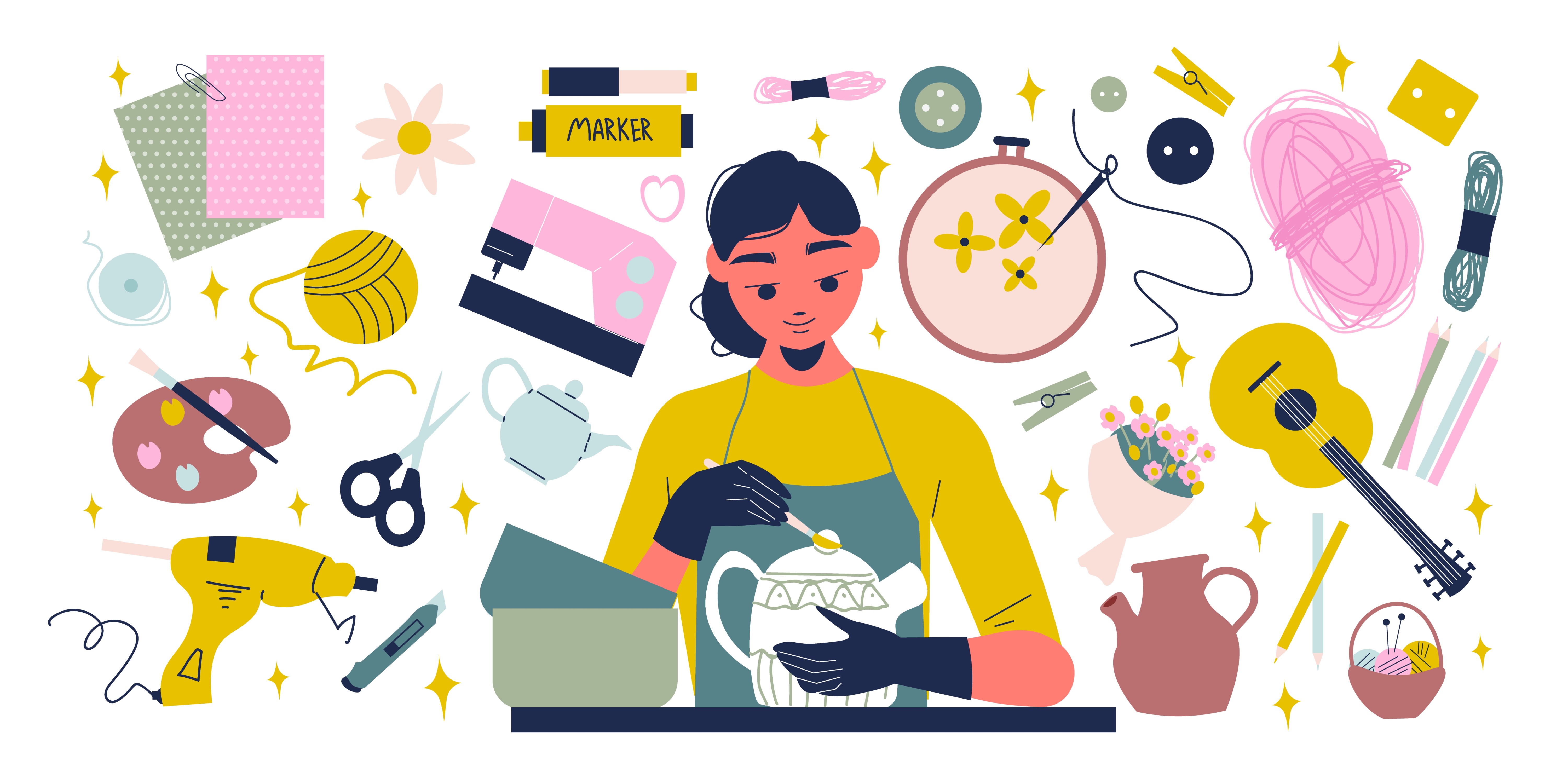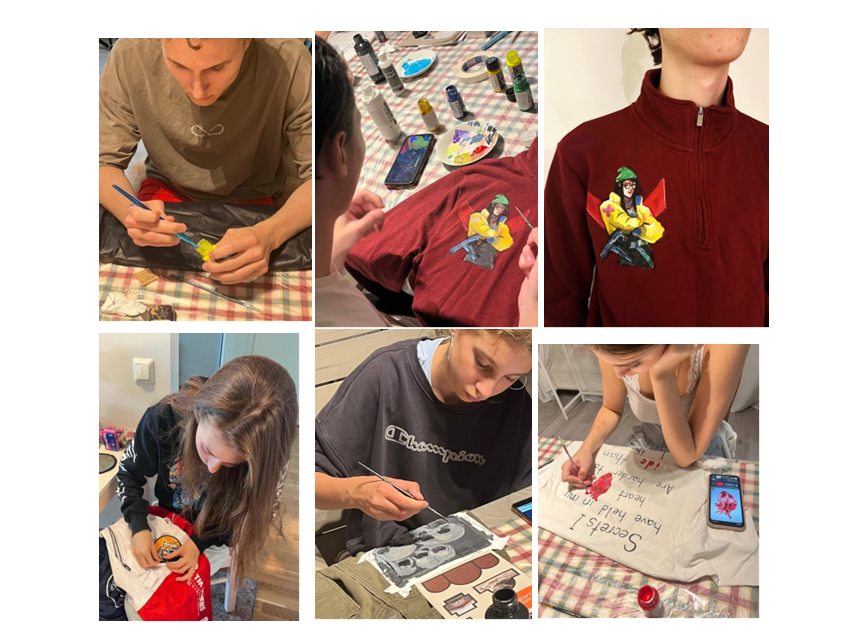How can fashion consumption become more sustainable? The participants of the VISU (Village for sustainable clothing) project have launched a set of workshops with young people to test various strategies for informing about and implying in practice the principles of sustainable fashion (see previous articles here and here). This article talks about an upcycling workshop that is aimed at prolonging the lifecycle of clothing through personalization, achieved by painting and using decorative patches.
 Photo by @
macrovector on Freepik
Photo by @
macrovector on Freepik
Fashion and individualization
German sociologist George Simmel (1957) wrote in his classical essay on fashion that fashion is a form of imitation, and, on the other hand, it differentiates one person from another. In other words, fashion is a reflection of both societal trends and a canvas for individual expression. The rise of social media and fast fashion chain stores in contemporary society has had an impact on the fashion landscape, making it global. Everyone can be exposed to freely circulating fashion trends and buy them. However, this shift has also created tension, as it is easy to lose individuality and uniqueness. In response to that, we launched an upcycling workshop at the Hygge Way second-hand shop in Helsinki with a goal to emphasize the importance of personalization of clothing and, by doing so, to contribute to prolonging their lifecycle and sustainable clothing consumption.
Looking back at the history of personalization in fashion, we can connect it to growth of youth subcultures in the second half of the 20th century , as described in the classical book by Dick Hebdige on subcultures (1979). These subcultures challenged the dominant culture by means of style. For them, style was a tool of revolt, refusal, and protest. For instance, punks in the UK detached themselves from the taken-for-granted normalized forms of clothing. The punks ripped up their T-shirts, added studs to leather jackets, and liberally applied paint. In other words, for a long time, personalization has been associated with creative individuals who rejected conformity with dominant norms and emphasized the value of challenging them and standing out.
Brands, both luxury and mass-consumer, have been interested in appropriating the trend toward personalization in one way or another. Brands adapted to this by introducing personalization services that allowed customers to become active participants in creating their own fashions. For example, Dior launched a personalization service called ABCDior for customers. This service allows you to “express your singularity through delicate embroidery, where letters, figures and symbols are unveiled in the colors of your choice” (Dior 2023). Another example is Muji in Helsinki, which also offers customization through embroidery and sewing (Picture 1). These are ways of personalizing new clothing items.
 Picture 1. Customization at the Muji store in Kamppi in Helsinki. Photo: Olga Gurova
Picture 1. Customization at the Muji store in Kamppi in Helsinki. Photo: Olga Gurova
An upcycling workshop as a tool for personalizing clothing
We decided to focus on used clothing and emphasize a different way of personalization: upcycling. Upcycling is a mix of customization and recycling. It assumes converting used clothing or materials into something with greater value in a second life (Gurova & Morozova 2018). Upcycling means an investment of creativity into a clothing item, and painting on clothes is one great tool for doing that. Upcycling is a way of prolonging the lifecycle of clothing, and, therefore, it has the potential to contribute to sustainability if it is successful. It can, however, also ruin a garment. We’re not discussing this last case, although it should be mentioned.
The upcycling workshop was organized in the second-hand store Hygge Way in Helsinki by Laurea’s Service Innovation and Design student Eleonora Prits for the VISU project. VISU, standing for the “Village for sustainable clothing—bringing together educators, young consumers, and companies”, is financed by the Regional Council of Uusimaa and implemented by Laurea together with the Finnish Textile and Fashion Association (Suomen Tekstiili ja Muoti RY). The goal of the workshop was to draw attention to sustainable fashion practices.
The participants of the workshop were five young people aged 17–20. Before embarking on the hands-on activities, participants were introduced to the principles of sustainable fashion. The workshop emphasized that the individual work done during the class serves as a tangible means of extending the lifecycle of clothing items (Gwilt & Rissanen 2011). This educational component aimed to increase understanding of the environmental impacts associated with clothing consumption and ways of preventing negative impacts.
Then, four participants engaged in hands-on activities to personalize their clothing through painting. One participant took the opportunity to sew decorative patches onto her student overall. She felt she wanted to do this creative endeavor that she had not had time for before. The use of special textile dyes complemented the creative process, adding a unique touch to each participant’s piece of clothing (Picture 2).
 Picture 2. Personalization of clothing through painting and adding decorative patches. Participants gave their consent for the publication of their images. Photo: Eleonora Prits.
Picture 2. Personalization of clothing through painting and adding decorative patches. Participants gave their consent for the publication of their images. Photo: Eleonora Prits.
After the hands-on activities, participants were asked to complete a short questionnaire. The questionnaire assessed the impact of the workshop on learning about sustainable fashion consumption.
This VISU initiative resonated with the wider discussion on sustainable fashion, which aligns with upcycling and redesign practices (Fletcher 2014). The initiative emphasizes the practical application of sustainable fashion principles and the role of workshops in developing applied skills for practicing them. The young people learn to extend the lifecycle of clothing by engaging in practical activities such as painting on clothing or sewing on patches (Gwilt & Rissanen 2011).
The connection between personalization and sustainable fashion is multifaceted. A customized item is more than just a thing, it can becomes – metaphorical speaking – an extension of the person . It can reflects their uniqueness in a world of mass clothing from chains. Since an effort and creativity were invested in it, a customized item is more likely to be cherished, worn longer and won’t end up in a landfill. The heart and effort put into creating personalized items makes them irreplaceable, contributing to a more sustainable and reusable fashion culture.
Therefore, the VISU upcycling workshop was aimed at encouraging sustainable fashion behavior through celebrating individuality and uniqueness. The workshop served as a reminder of the importance of choosing sustainability over fast fashion and utilizing the power of personal expression in a world where mass-produced fashion still dominates.
References
- Dior n.d. ABCDior personalization.
- Fletcher, K. 2014. Sustainable fashion and textiles. Design journeys. London and New York: Routledge.
- Hebdige, D. 1979. Subculture: The meaning of style. London and New York: Routledge.
- Gurova, O. & D. Morozova. 2018. “A Critical Approach to Sustainable Fashion: Practices of Clothing Designers in the Kallio Neighborhood of Helsinki”, Journal of Consumer Culture, 18(3), 397-413.
- Gwilt, A. & T. Rissanen. 2011. Shaping Sustainable Fashion. Taylor & Francis.
- Simmel, G. 1957. “Fashion”, American Journal of Sociology, 62(6), 541-558.